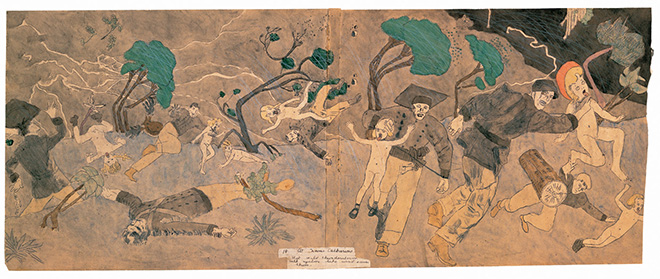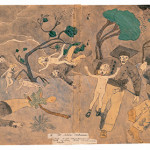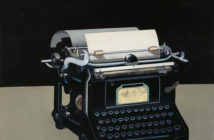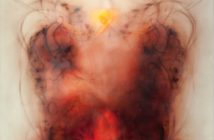The work of Henry Darger made its grand-scale public debut in 1997 at the American Folk Art Museum. Almost immediately, his phantasmagoric landscapes, populated by pre-adolescent girls with male genitalia, gave rise to a new breed of narrative artists like Marcel Dzama and Amy Cutler; cute, precocious little girls behaving strangely were appearing everywhere. Initial critical reception of Darger’s work in the 1980s, when it was dismissed as the product of a depraved pedophile, was quickly reassessed. As most of the facts about Darger’s life have come to light (we have his work, his writing and his neighbors’ accounts to draw on,) he is still shrouded in mystery and more questions remain open than answered (even the pronunciation of his name remains under debate, with no consensus of a hard or soft g).
In his 2013 biography Henry Darger, Throwaway Boy: The Tragic Life of an Outsider Artist, Jim Elledge approaches his subject through the lens of Queer Theory, leaving so little room for debate that it fairly begs for further readings of the work. He does give us a well-researched account of the social, legal and medical "cures" for homosexuality in the early twentieth century as well as a vivid portrait of Chicago’s seedy gay underground during this time. It is here that the book informs the most, using a solid chronology of Darger’s life as its structure.
Darger was born in 1892 to first-generation German immigrants—among the thousands that poured into the Chicago slums and shantytowns, as described in vivid detail by Upton Sinclair in his novel The Jungle about the Chicago meat industry. Henry’s mother died giving birth to his baby sister, who was promptly put up for adoption without Henry ever having seen her. His vanished sister triggered a life-long obsession with missing children— particularly girls. When Henry was around six, his father sank into morbid and degenerate alcoholism, and with a scant roof over his head and no means of feeding himself, Henry took to cruising the gay sex circuits of squalid tenements and black-bottom slums that made up his neighborhood. With a police record by the age of eight, he was sent to The Mission of Our Lady of Mercy, a Catholic detention center for juvenile delinquent males.
 Henry Darger (1892-1973)
Henry Darger (1892-1973)18 At Norma Catherine. But wild thunderstorm with cyclone like wind saves them. (double-sided)
Chicago
Mid-twentieth century
Watercolor, pencil, colored pencil, and carbon tracing on pieced paper
19 1/8 x 47 3/4"
Collection American Folk Art Museum, New York
Museum purchase, 2002.22.2A
© Kiyoko Lerner
Photo by James Prinz
The Mission had its own sexual pecking order, with larger boys dominating the smaller ones, and Henry went from hustling on the streets to exchanging sexual favors for protection in an environment where the authority figures turned a blind eye. Around the time his father died in 1905, the thirteen year-old was caught masturbating and was taken from the nuns at the mission to the doctors at the Illinois Asylum for Feeble-Minded Children, where he was summarily diagnosed as "crazy." (He was to escape at age 17 to begin lifelong employment as a janitor, the only skill the boy learned while institutionalized.)
The medical community employed numerous "treatments" for homosexuality as the Victorian Age gave way to the new century. "Self-abuse" was thought to sap the masculinity of its practitioners and, if not held in check, could feminize men to the extent that they could pass the seeds of perversion down to successive generations to usher in a new breed of epicene, ineffectual and impotent men. Androgyny, hermaphrodites and the blurring of defined gender traits confounded doctors, the consensus being that within the corporeal make-up of the homosexual was an abundance of female hormones that caused in its "sufferers" the desire to be female.
With a childhood and adolescence spent within the humiliating and alienating confines of institutions that fomented the very homosexual tendencies they were battling, it is certain that the young Henry would have felt emasculated, but does that make him a homosexual by default, and was he homosexual at all? Without a doubt, his sexual sphere was limited to aggressive, dominating males, but if he was gay, we cannot determine if his "condition" was predisposed or the result of his upbringing. Elledge leans toward the former, positing that Darger’s life-long friendship with another male patient at Our Lady of Mercy was of a sexual nature, though the existing (and not particularly disclosing) correspondences indicate that his conclusion rests heavily upon speculation. While the letters overflow with the affections of a close friendship, they prove only that Henry was not, as popular legend has it, friendless. Without first-hand accounts, one must turn to the work itself to draw conclusions.
Darger began his epic, meandering opus In the Realms of the Unreal at age 19. The Realms portrays an army of hermaphroditic young girls that Henry dubbed The Vivian Girls. Eternally youthful and nymphish, The Vivian Girls fight endlessly to free child slaves from the nefarious "Glandelinians" across inimical terrain and endless landscapes where the elements reflect the fear, bloodshed and drama. The Glandelinians comprise all of the traits that Henry found threatening: strength, the ability to overpower, and sadism (especially toward children). Drawn on long, frieze-like sheets of found paper (which Elledge erroneously refers to as "canvases"), Henry traced and collaged his figures (convinced that he could not draw) and painted weather-obsessed skies across the landscapes where the drama plays out. But despite his reliance on tracing, he was not without ability: he could adeptly change facial expressions, cloths and hair to fit his needs, and it is with unique and masterful facility that he applied his washes to portray all manner of storms, skies and clouds.
Accompanying this epic battle, in all of its slaughter, torture, disembowelment, flight and saintly revivification is a 15,145 typewritten-page verbal narrative. A thinly concealed pathos toward the indignities that Henry suffered at the hands of predatory males in his youth is laced throughout The Realms (he even named a lead villain after a boy who bullied him). The lead characters, "The Vivian Princesses," may represent Henry and some of his friends from the mission. Unfinished upon his death at the age of 82, the text is almost unreadable, so repetitive is the seemingly directionless narrative, devoid of any semblance of a story arc and alternated with endless accounts of weather (in his 5,000 page autobiography that he wrote concomitantly, 4,878 pages describe weather). While In the Realms has been transcribed and excerpts from the bizarre, wordy (and decidedly unschooled, "outsider") text can be found in monographs of the artist, plans for a complete, multi-volume publication have been put on hold for years, since no one but the most dedicated Darger scholars would have the patience to slog through it.
 Henry Darger (1892-1973)
Henry Darger (1892-1973)175 At Jennie Richee. Everything is allright though storm continues. (double-sided)
Chicago
Mid-twentieth century
Watercolor, pencil, carbon tracing, and collage on pieced paper
24 x 108 1/4"
Collection American Folk Art Museum, New York
Museum purchase, 2001.16.2A
© Kiyoko Lerner
Photo by James Prinz
Henry’s landlady, Kiyoko Learner, who, with her husband, discovered the trove of Henry’s work after he moved out, describes Henry as reclusive and somewhat off-putting. He was dirty and smelled from infrequent bathing; he carried on dialogues with himself in different voices, tones and accents; he recounted fantastic, impossible stories about himself he clearly thought were true; and he rummaged through garbage in search of source material. Before leaving for the nursing home where he was to die, he told Learner she could throw his drawings and collected volumes and source material away: "They’re of no use to me anymore."1
An author of several books on Queer Studies, Elledge’s reading of Darger seems to be the product of his academic background. With his oeuvre of poetry anthologies, literary biography, criticism and queer history, his lack of in-depth discussion of Darger’s techniques and process belies his lack of scholarship and comfort as a visual arts writer. Attention is owed to the bold, unschooled method of the work’s creation: the overlapping tracings with vividly-applied colors from five-and-ten cent store paint sets; the use of collage seamlessly integrated into the imagery at a time when practitioners of the medium were making no attempt to disguise the appropriation of sources; the narrative structure, archetypal in an historical context with which Darger had no familiarity. Elledge’s cocksure assertion that the Vivian Girls are homosexual boys inhabiting the bodies of little girls (but for the telltale organ) is in keeping with the gender theory of Henry’s day (with which Henry was possibly familiar) but in the end, this is impossible to say, for theories surrounding Darger are always based upon the work and thus never more than hypothetical.
In a 1996 article for Raw Vision magazine, John MacGregor theorizes that Henry’s preoccupation with orphans (he saved countless newspaper clippings on kidnapped children) stemmed from having lost his baby sister to adoption as a boy, prompting a desire to adopt a child himself and thus retroactively saving his lost sibling from unknown peril. His suggestion that the images of little girls (from newspapers, circulars and other sources) that Darger saved, were surrogate adoptions, or that his disemboweled girls were a sublimation of his wish to give birth, is especially far-fetched.
In Jessica Yu’s 2004 documentary film In The Realms of the Unreal, Henry’s neighbor Regina Waters suggests that Darger drew his females with male genitalia because had never actually seen a naked female and thus assumed that all bodies looked the same.2 While Throwaway Boy does a fine job of recounting the havoc wreaked on a hapless boy on the predatory streets of old Chicago and at the hands of doctors and correctional institutions, its certitude only invites more theories. Since he never meant his work to actually be seen at all, it is futile to even imagine an attempt on Darger’s part to convey or impart some sort of message or meaning to anyone but himself, and herein lies the nature of Darger as a true outsider: the driven, obsessive creation of work without a thought (or desire) of its being seen by anyone but himself. Except for a passing mention of the German outsider Adolph Wölfli, Elledge does not discuss Darger in context of outsider art (such as contrasting him with his predecessors, followers or non-outsider imitators; the collecting and preserving of art from European institutions during the early twentieth century by the trailblazing German psychiatrist Hans Prinzhorn; or his modern-day status as the first "Superstar" outsider). With an artist indifferent or oblivious to a potential interest in a market for his work, how do we speculate on its meaning? Even without knowing about his tragic, emotionally damaging upbringing, the work leaves no doubt of grave sexual confusions, possible misinterpretations and perversions, whether personal and harmless or perhaps of a more dangerous nature. But we can never know. In the end it is left to the scholar or the casual viewer to draw their own (often projective) conclusions. Perhaps the only way of ever understanding the mystery of Darger’s work was best summarized by Learner: "You’ll have to ask him in the next life."3
- Henry Darger (1892-1973) 175 At Jennie Richee. Everything is allright though storm continues. (double-sided) Chicago Mid-twentieth century Watercolor, pencil, carbon tracing, and collage on pieced paper 24 x 108 1/4″ Collection American Folk Art Museum, New York Museum purchase, 2001.16.2A © Kiyoko Lerner Photo by James Prinz
- Henry Darger (1892-1973) 18 At Norma Catherine. But wild thunderstorm with cyclone like wind saves them. (double-sided) Chicago Mid-twentieth century Watercolor, pencil, colored pencil, and carbon tracing on pieced paper 19 1/8 x 47 3/4″ Collection American Folk Art Museum, New York Museum purchase, 2002.22.2A © Kiyoko Lerner Photo by James Prinz
[1] Biesenbach, Klaus (ed), Henry Darger Disasters of War (Berlin, Institute for Contemporary Art, 2000), 17
[2] MacGregor, John. "Art by Adoption." Raw Vision Winter, 1995-96: 28
[3] In the Realms of the Unreal. dir. Yu, Jessica. Diorama Films, 2004






